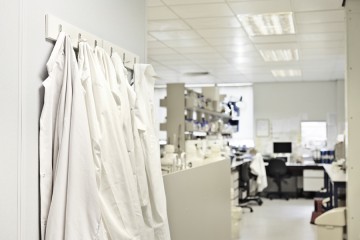The U.S. biomedical research system has long been an engine of innovation that has saved countless lives and catalyzed job growth. But there are growing concerns that the scientists powering that engine are being held back by several core challenges, among them the barriers facing early-career researchers: Many newly awarded biomedical PhDs spend long periods in postdoctoral positions with low salaries, inadequate training, and little opportunity for independent research.
A new report—issued today by the National Academies of Sciences, Engineering, and Medicine, in response to a request by the U.S. Congress—calls for a series of reforms to break down those barriers and strengthen the U.S. biomedical research system for the next generation of scientists. The report, authored by a 17-member committee chaired by Johns Hopkins University President Ronald J. Daniels, spells out a number of recommendations for Congress, federal agencies, and research institutions; identifies obstacles that have impeded past reform efforts; and proposes means to overcome them.
Several national reports have wrestled with these issues and proposed reforms, many of which have not been implemented. What makes this report different is its focus on removing the roadblocks that prevented past progress, hampering the nation's ability to recruit the best minds to pursue careers in biomedical research.
"As we surveyed the biomedical research landscape, we saw remarkable achievement and promise, but also areas of stress and vulnerability," Daniels said. "Our recommendations seek to respond to those vulnerabilities and put in place the structures and conditions for sustained change—so that the need for episodic reports starts to fall away, replaced instead by ongoing, enduring policy change across the enterprise."
Among the committee's recommendations:
- Creating more research scientist jobs at universities and research institutes, permanent, non-faculty positions that would offer reasonable salaries and benefits as an additional off-ramp to temporary and low-paying postdoctoral fellowships
- Making better data on career paths inside and outside universities available to students and postdoctoral researchers
- Creating a new council to broaden responsibility among public and private stakeholders alike for the future of the research ecosystem
- Developing a systemwide approach to improving diversity in the biomedical workforce
- Increasing policy experimentation and investment in that research ecosystem, so that scientists are empowered to imagine the next generation of treatments for diseases and improvements to our health and well-being
- Increasing the budget of the National Institutes of Health to enable it to better support early career researchers
The report responds to years of warning signs that the U.S. biomedical enterprise may be calcifying in ways that create barriers for the incoming generation of researchers. One of the biggest challenges is the gulf between the growing number of young scientists who are qualified for and interested in becoming academic researchers and the limited number of tenure-track research positions available.
Many postdocs pursue training experiences expecting that they will later secure an academic position, but the majority will end up employed outside of academia. For those researchers who do transition into independent research positions, the average age for securing their first major NIH independent grant, as of 2016, was 43 years old, compared to 36 years old in 1980.
At Johns Hopkins, the faculty-led Committee on the Biomedical Scientific Workforce spent more than a year examining these challenges at the university and in December issued a 40-page draft report offering 24 recommendations for how Hopkins can strengthen its support for its biomedical workforce. The group is now working with university leadership to incorporate feedback received from the university community into a final report and develop an implementation plan.
Also in December, Johns Hopkins—along with eight other U.S. research universities and a major cancer institute—announced plans to give aspiring life scientists clear, standardized data on graduate school admissions, education and training opportunities, and career prospects. The group published its first data set in February.
Both efforts are a response to the same stresses that prompted the report issued today—declines in federal research funding, the limited number of academic career opportunities, and the absence of reliable information on rewarding alternative careers for talented scientists.
"[Johns Hopkins is] the place where the next generation of science leaders will be trained and then work together to produce the discoveries of tomorrow," Daniels and Provost Sunil Kumar wrote in a message to faculty, staff, and students in December. "We have a responsibility to them, not only to honor best practices but to define those practices—by working assiduously to create the strongest possible platform for our scientists."
The report issued today was sponsored by the National Institutes of Health and the Bloomberg Philanthropies. The full report, The Next Generation of Biomedical and Behavioral Sciences Researchers: Breaking Through, is available online.
Posted in Science+Technology, University News










